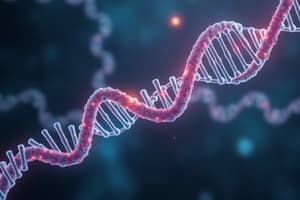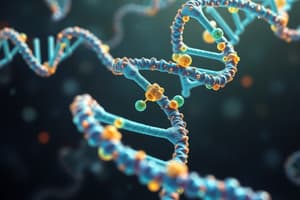Podcast
Questions and Answers
What is the primary role of mRNA in protein synthesis?
What is the primary role of mRNA in protein synthesis?
- It carries the codon sequence for protein synthesis. (correct)
- It is involved in the folding of DNA into chromosomes.
- It transfers amino acids to the protein chain.
- It provides structural support to the ribosome.
How many hydrogen bonds form between adenine and thymine in DNA?
How many hydrogen bonds form between adenine and thymine in DNA?
- 3
- 1
- 2 (correct)
- 4
What is the shape of tRNA?
What is the shape of tRNA?
- Ball-shaped
- Helical
- Linear
- Clover leaf shaped (correct)
Which of the following best describes histones?
Which of the following best describes histones?
Which nitrogenous base is found in RNA but not in DNA?
Which nitrogenous base is found in RNA but not in DNA?
What type of sugar is present in DNA?
What type of sugar is present in DNA?
Which bond links nucleotides in a nucleic acid?
Which bond links nucleotides in a nucleic acid?
How many hydrogen bonds are formed between guanine and cytosine?
How many hydrogen bonds are formed between guanine and cytosine?
What is the structure of DNA as described in Watson-Crick model?
What is the structure of DNA as described in Watson-Crick model?
What term describes the ends of a nucleotide chain where no additional nucleotides are attached?
What term describes the ends of a nucleotide chain where no additional nucleotides are attached?
What characteristic of DNA allows it to separate into single strands?
What characteristic of DNA allows it to separate into single strands?
What unique feature do the two strands of DNA have as described in the Watson-Crick model?
What unique feature do the two strands of DNA have as described in the Watson-Crick model?
What are the components of a nucleotide?
What are the components of a nucleotide?
Which of the following correctly describes RNA?
Which of the following correctly describes RNA?
Identify the correct pairing of nitrogenous bases in DNA.
Identify the correct pairing of nitrogenous bases in DNA.
Which statement about DNA and RNA is true?
Which statement about DNA and RNA is true?
What type of sugar is found in DNA?
What type of sugar is found in DNA?
What are the two categories of nitrogenous bases?
What are the two categories of nitrogenous bases?
Which nitrogenous base is only found in RNA?
Which nitrogenous base is only found in RNA?
Which structural feature distinguishes DNA from RNA?
Which structural feature distinguishes DNA from RNA?
Flashcards
What is DNA?
What is DNA?
A polymer of nucleotides, the building blocks of life. It stores and transmits genetic information essential for the growth and function of all living organisms. DNA is found in the nucleus of eukaryotic cells and the cytoplasm of prokaryotic cells.
What is RNA?
What is RNA?
A single-stranded polymer of nucleotides that plays a crucial role in protein synthesis. It acts as a messenger, carrying genetic information from DNA to ribosomes, where proteins are made. RNA is found in the cytoplasm of eukaryotic cells and the cytoplasm and nucleus of prokaryotic cells.
What is a nucleotide?
What is a nucleotide?
A molecule composed of a nitrogenous base, a pentose sugar, and at least one phosphate group. Nucleotides are the building blocks of nucleic acids (DNA and RNA).
What is a nucleoside?
What is a nucleoside?
Signup and view all the flashcards
What is deoxyribose?
What is deoxyribose?
Signup and view all the flashcards
What is ribose?
What is ribose?
Signup and view all the flashcards
What is a purine?
What is a purine?
Signup and view all the flashcards
What is a pyrimidine?
What is a pyrimidine?
Signup and view all the flashcards
Nitrogenous Bases in DNA
Nitrogenous Bases in DNA
Signup and view all the flashcards
Nitrogenous Bases in RNA
Nitrogenous Bases in RNA
Signup and view all the flashcards
Deoxyribose in DNA
Deoxyribose in DNA
Signup and view all the flashcards
Ribose in RNA
Ribose in RNA
Signup and view all the flashcards
DNA Structure: Double Strand
DNA Structure: Double Strand
Signup and view all the flashcards
RNA Structure: Single Strand
RNA Structure: Single Strand
Signup and view all the flashcards
DNA Polymer
DNA Polymer
Signup and view all the flashcards
RNA Polymer
RNA Polymer
Signup and view all the flashcards
What are the Watson-Crick base pairings in DNA?
What are the Watson-Crick base pairings in DNA?
Signup and view all the flashcards
What is the function of mRNA?
What is the function of mRNA?
Signup and view all the flashcards
What is the function of tRNA?
What is the function of tRNA?
Signup and view all the flashcards
What is the function of rRNA?
What is the function of rRNA?
Signup and view all the flashcards
What are histones, and what role do they play in chromosome structure?
What are histones, and what role do they play in chromosome structure?
Signup and view all the flashcards
Study Notes
Nucleic Acid Structure
- PowerPoints are supplementary material, not replacements for textbooks. Recommended textbooks are essential for complete understanding and exam preparation.
- Learning objectives for the lectures include: defining nucleosides, nucleotides, and nucleic acids; classifying and listing nitrogenous bases; describing DNA structure and properties; describing different types of RNA; and outlining DNA organization into a chromosome.
- Nucleic acids are polymers of nucleotides. DNA is a double-stranded helical polymer of deoxyribonucleotides. RNA is a single-stranded polymer of ribonucleotides. DNA forms a double helix.
- Nucleotides are composed of a nitrogenous base, a pentose sugar, and at least one phosphate group. A nucleotide includes a nitrogenous base, a pentose sugar (ribose/deoxyribose), and one or more phosphate groups. A nucleoside is a nitrogenous base and a pentose sugar.
- DNA and RNA differ in their nitrogenous bases and pentose sugars.
- Nitrogenous bases are of two types: Purines (Adenine (A) and Guanine (G) - 9 membered ring) and Pyrimidines (Thymine (T), Cytosine (C), and Uracil (U) - 6 membered ring)
- DNA contains Adenine, Thymine, Guanine, and Cytosine. RNA contains Adenine, Uracil, Guanine, and Cytosine.
- DNA's pentose sugar is deoxyribose, while RNA's is ribose.
- DNA is double-stranded, while RNA is single-stranded.
- DNA is a polymer of deoxyribonucleotides, while RNA is a polymer of ribonucleotides.
- The phosphate group (PO4) bridges the 3' and 5' positions of ribose sugar via a phosphodiester bond.
- The terminal nucleotide with a free 5' carbon is the 5' end. The terminal nucleotide with a free 3' carbon is the 3' end.
- The melting temperature (Tm) of DNA depends on the G-C content, as G-C bonds have three hydrogen bonds (stronger than A-T's two hydrogen bonds).
- DNA's structure was determined by Watson and Crick in 1953 and has a double helix structure
- Three types of DNA structures are A-DNA, B-DNA, and Z-DNA; B-DNA is the most common form.
- Watson-Crick DNA structure features two polynucleotide chains forming a double helix around a common axis. The strands are antiparallel and each is a right-handed helix. The nitrogenous bases are in the center and the sugar-phosphate chains on the sides. The helix has 10 base pairs per turn.
- Complementary base pairing occurs between the bases (A-T and G-C) through hydrogen bonds. (A=T; G=C)
- There are 3 dimensional structures for DNA.
Types of RNA
- mRNA (messenger RNA) is linear, derived from DNA by transcription, and carries the codon sequence for protein synthesis.
- rRNA (ribosomal RNA) is involved in protein synthesis (translation), ribosomes are protein synthesis sites and are composed of ribosomal RNA.
- tRNA (transfer RNA) is clover-leaf shaped and involved in protein synthesis (translation), transferring amino acids to the growing protein chain.
Chromosome Structure
- DNA is organised into chromosomes within the nucleus.
- DNA is wrapped around histones to form nucleosomes.
- Nucleosomes undergo further folding to form chromosomes.
- Histones are positively charged proteins rich in basic amino acids (arginine and lysine).
Studying That Suits You
Use AI to generate personalized quizzes and flashcards to suit your learning preferences.




